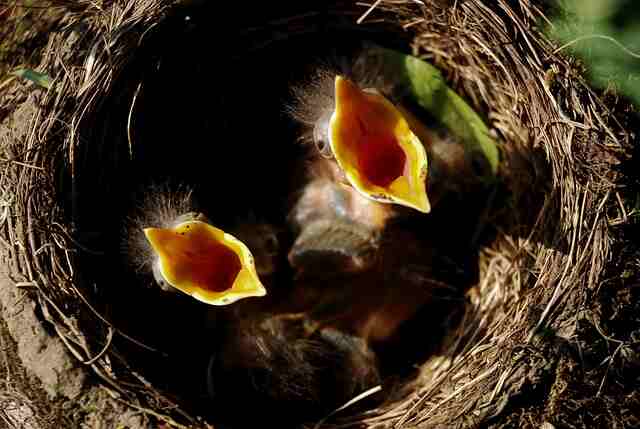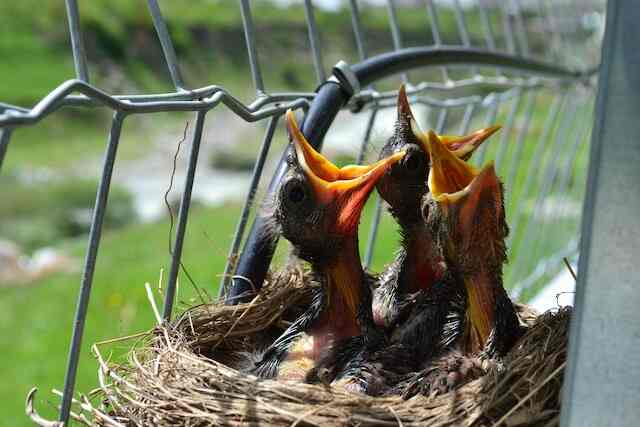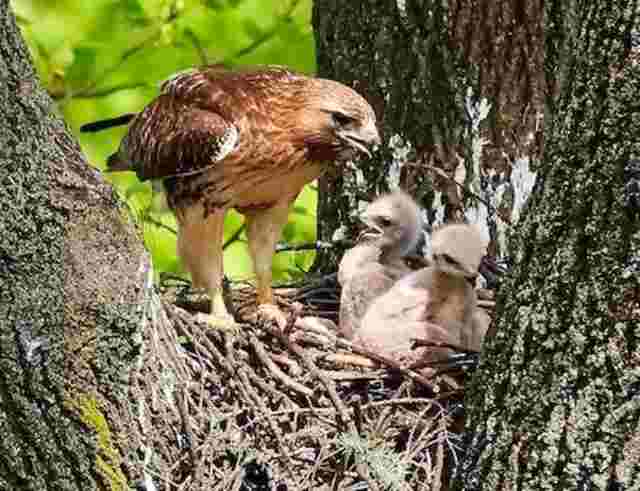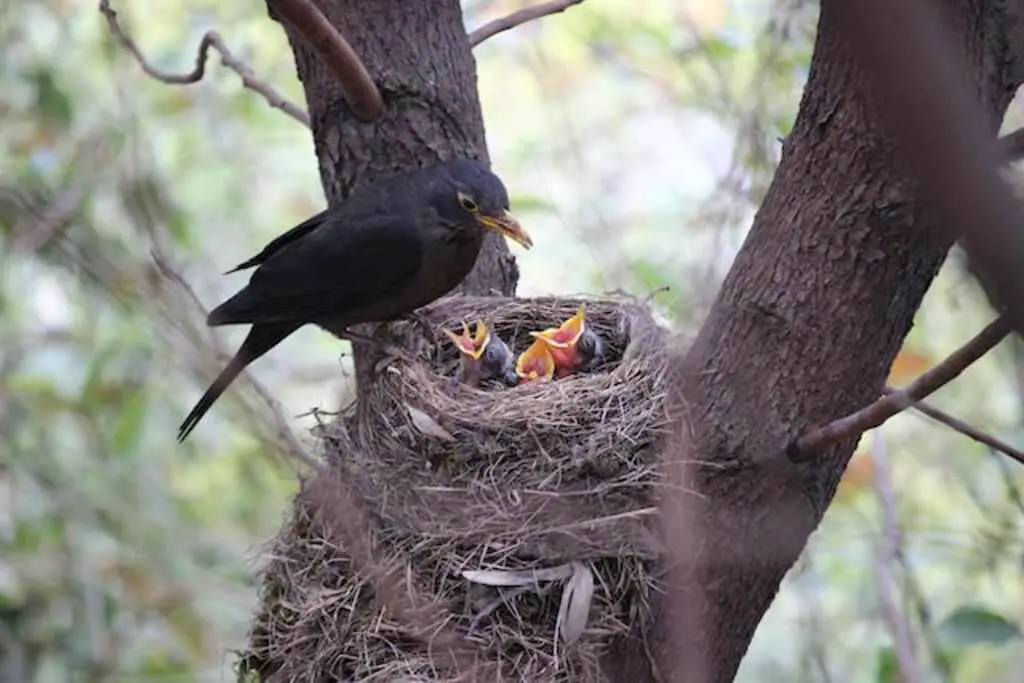Birds are known for their unique and fascinating care of their offspring. From the moment a bird’s egg is laid to the time when the young are ready to fledge and leave the nest, there are many different ways in which birds provide for their offspring. This includes everything from building and maintaining a nest, to incubating eggs, to feeding and protecting their young.
In this article, we’ll take a closer look at the various ways in which birds care for their offspring, and how they ensure that their young are well-fed and healthy. Whether you’re an avid birdwatcher or simply curious about the natural world, there’s always something new to learn about the amazing ways in which birds raise their young.
Table of Contents
The Process of Feeding Young Birds
Feeding young birds is a critical process for their survival, and different bird species have unique feeding strategies. Here’s what you need to know about how birds feed their young:
How do birds feed their young?
Birds have various feeding methods for their young, but most use regurgitation. Parent birds gather food and store it in their crops, then regurgitate the partially digested contents into their offspring’s mouths. Some species also use direct feeding or even feeding through the eggshell. Young birds usually beg for food by vocalizing or flapping their wings, triggering their parents’ feeding response.
Do birds regurgitate food to feed their young?
Yes, regurgitation is a common feeding method used by many bird species to feed their young. The parent bird will consume food and store it in their crop, where it is partially digested. They then regurgitate the contents into their offspring’s mouth, providing them with a nutrient-rich diet that promotes healthy growth and development.
How often do birds feed their young?
The frequency of feeding young birds varies depending on the bird species and the age of the chicks. Some species may feed their young as often as every 15 minutes, while others may feed less frequently. During the first few days after hatching, chicks may require almost constant feeding, while as they get older, they may be fed less often as they begin to forage on their own.
What does regurgitated bird food look like?
Regurgitated bird food typically appears as a soft, partially digested mass that may have a different color or texture than the original food. Depending on the bird species and diet, the regurgitated food may contain a mix of insects, seeds, fruit, or other food items that the parent bird has consumed and partially broken down in their crop. This partially digested food provides young birds with a rich source of nutrients and energy for healthy growth and development.
Types of Food for Baby Birds
When it comes to caring for baby birds, it’s important to provide them with the right nutrition to support their growth and development. In this section, we will discuss the different types of food that baby birds eat, how to feed them, and how often they need to be fed. By understanding the dietary needs of baby birds, you can help ensure that they receive the proper nutrition for healthy development.
What kind of seeds do baby birds eat?
Baby birds have different dietary requirements depending on their species. In general, they need a protein-rich diet to support their rapid growth and development. Many species of birds feed their young insects, while others feed them a variety of seeds, fruits, and nuts. Some species, such as doves and pigeons, regurgitate a special crop milk to feed their young. It’s important to research the specific diet of the bird species you are caring for to ensure that they receive the proper nutrition they need.
How do you feed a baby bird?
Feeding a baby bird requires care and attention to ensure that they receive the right amount and type of food. Depending on the bird species, you may need to feed them with a syringe or pipette, or offer food with tweezers. For very young birds, you may need to provide a special formula that mimics the nutrients found in their mother’s milk. When feeding a baby bird, it’s important to avoid overfeeding and to provide fresh water regularly.
How often do you feed a baby bird?
How often to feed a baby bird varies based on their species and age. Very young birds require frequent feedings, often every 15 to 30 minutes, while older birds can go longer between feedings. Generally, it’s recommended to feed baby birds every 2 to 3 hours during the day, and to reduce the frequency of feedings as they get older and begin to eat solid food. It’s important to pay attention to the bird’s behavior and appetite to determine the appropriate feeding schedule.

Care and Feeding by Mother Birds
Mother birds play a crucial role in the survival of their offspring, providing not only food but also protection and warmth. They are highly attuned to the needs of their young and use a variety of techniques to ensure their wellbeing.
In this section, we will explore the different ways that mother birds care for and feed their young, highlighting some of the remarkable strategies they use to ensure their offspring’s survival.
How do mother birds take care of their babies?
Mother birds are devoted parents and take great care to ensure the health and safety of their offspring. They incubate their eggs until they hatch and then continue to provide warmth and protection to their babies. Mother birds also feed their young, often by regurgitating food into their beaks. They keep the nest clean by removing fecal sacs and other waste to maintain a healthy environment for their young.
Do Mama birds feed their babies at night?
Yes, many mama birds feed their babies at night. Baby birds have high metabolisms and need to be fed frequently, even throughout the night. Mother birds may adjust their feeding schedules to ensure that their young are getting enough nourishment and growing properly.
Do birds sleep with their babies?
Some species of birds may sleep with their babies, while others do not. In general, birds do not sleep in the same way that humans do, but rather have periods of rest throughout the day and night. Some birds, such as doves and pigeons, may cuddle with their young to provide warmth and protection.
Do mother birds sit on their babies after they hatch?
Yes, mother birds often sit on their babies after they hatch. This helps to provide warmth and protection to the newborn chicks. As the chicks grow, the mother may gradually spend less time sitting on them, allowing them more space and freedom to move around the nest.
Why do baby birds poop right after eating?
Baby birds produce a waste product called a fecal sac, which is a membrane that surrounds their waste and makes it easier for the mother bird to remove it from the nest. The sac is usually produced shortly after the baby bird has been fed, and the mother bird will typically take the sac away and dispose of it to keep the nest clean and healthy.

Care and feeding by parent birds
Parent birds play a critical role in the care and feeding of their offspring, ensuring that their young have the necessary nutrients and protection to survive and thrive. From the method of feeding to the duration of parental care, there are many factors that contribute to the success of bird parenting.
In this section, we will explore the various ways in which parent birds provide for their young, including feeding habits, care strategies, and other behaviors that are crucial to the survival of their offspring.
How long do parent birds feed their young?
The duration of parent birds feeding their young depends on the bird species and the size of the nestlings. Generally, it can last from a few weeks to several months. For example, albatross parents feed their chicks for over six months, while some songbirds may feed their young for only a few weeks.
How do parent birds feed their young?
Parent birds feed their young in various ways, including regurgitation, catching and delivering live prey, or offering fruits and seeds. Some birds may also chew or break food into smaller pieces before feeding their young, while others may directly offer whole prey. The feeding method may vary depending on the bird species and the type of food.
Will a baby bird survive the night?
The survival of a baby bird overnight depends on various factors, such as its age, health, and environmental conditions. Some species of birds have nestlings that require constant feeding, while others can go several hours without food. Additionally, if a nestling is injured, sick, or abandoned, its chances of survival may decrease.

Allofeeding
Allofeeding, a behavior observed in many bird species, involves the feeding of another bird’s offspring by an adult that is not their biological parent. While it is often practiced as a form of parental care, allofeeding can also serve other social functions, such as improving an individual’s social status or increasing their reputation as a selfless member of the community.
In this section, we will explore the phenomenon of allofeeding in birds, including which species engage in this behavior, and the different reasons why it occurs.
What is Allofeeding?
Allofeeding, also known as communal feeding or cooperative feeding, is a behavior where one bird feeds another bird’s offspring. This behavior is commonly observed in some bird species, such as ravens, crows, and penguins. Allofeeding may occur between members of the same species or different species and can serve as a form of parental care and social bonding.
Examples of Birds that Allofeed
There are many bird species that exhibit Allofeeding behavior, which involves one bird feeding another bird’s offspring. Here are some examples of birds that Allofeed:
- Penguins: Emperor penguins are known to practice allofeeding where multiple adults will regurgitate food for a chick that is not their own. Meanwhile, king penguins see birds that do not breed but still help feed chicks as very honorable and kind.
- Crows: American crows have been observed allofeeding and providing food for the offspring of their close relatives.
- Doves: Mourning doves have been observed allofeeding within their breeding pair, where one adult will regurgitate food for the other adult to feed the nestlings.
- Ravens: Common ravens have been observed engaging in allofeeding and even feeding the young of different pairs.
- Sociable weavers: These birds are known for their communal nest-building behavior and often engage in allofeeding of their nestlings, both within and outside of their breeding pairs.
- Red-billed queleas: These birds, which are found in sub-Saharan Africa, form massive flocks and engage in allofeeding to ensure the survival of the young during breeding season.
These are just a few examples of bird species that practice allofeeding, but many others may also exhibit this behavior in the wild.In this way, allofeeding can serve different purposes for different species of birds, including improving social status or showing altruism.
Allofeeding Between Mates
Allofeeding between mates is a behavior commonly observed in some bird species, such as doves and pigeons. During allofeeding, the mate that is not incubating the eggs or brooding the young may bring food to the other mate, which is then regurgitated to feed the nestlings. This behavior can strengthen the pair bond and improve the reproductive success of the breeding pair.
Allofeeding And Parental Care
Allofeeding can also be a form of parental care, where adults may feed other nestlings in addition to their own offspring. This behavior can increase the survival rate of the nestlings and improve the overall reproductive success of the breeding pair. Allofeeding may also strengthen social bonds within the group or community, promoting cooperation and mutual benefits.

Case study: Lovebirds
Why do lovebirds break their eggs?
Lovebirds, a popular pet bird species, are known for their nesting habits. Unfortunately, some lovebird pairs have been observed breaking their own eggs, leaving bird enthusiasts to wonder why. While there’s no single answer to this question, it’s believed that some lovebirds may break their eggs if they feel stressed or threatened.
Other factors that may contribute to this behavior include poor nesting conditions or a lack of experience with egg incubation. However, it’s important to note that not all lovebirds engage in this behavior and that providing a suitable nesting environment can help prevent it.
Interesting Bird Feeding Behaviors
Birds have a wide variety of feeding behaviors, ranging from the basic act of foraging for food to more complex behaviors like regurgitation and filial cannibalism. Some bird species have unique adaptations and behaviors that allow them to find food in unusual environments or to care for their young in unconventional ways.
In this section, we will explore some of the most interesting and surprising bird feeding behaviors, shedding light on the fascinating world of avian biology and behavior.
What bird feeds itself to its babies?
The European Roller is known for its unique behavior of feeding itself to its young. During nesting season, the male roller brings food to the female, who remains in the nest to incubate the eggs. Once the chicks hatch, the male continues to bring food to the female, who then regurgitates the food into the chicks’ mouths. However, sometimes the male will regurgitate food directly into the chicks’ mouths, a behavior known as “king-feeding.”
Do birds eat their own young?
While it may seem like a gruesome act, some birds do eat their own young in certain circumstances. This behavior, known as filial cannibalism, may occur when food is scarce or when the young are sick or weak. Some species that are known to engage in this behavior include eagles, hawks, gulls, and storks. However, it is important to note that this behavior is not common and is only seen in a small number of bird species.
Do birds feed themselves?
Yes, most bird species are able to feed themselves. Adult birds typically use their beaks to forage for food, whether it be insects, seeds, fruits, or other prey. Some species, such as hummingbirds, may require more frequent feeding due to their high metabolism, but they are still able to feed themselves. However, there are some bird species, such as the American Dipper, that have unique adaptations for underwater feeding, which allows them to find food in aquatic environments.
Conclusion
In conclusion, it’s fascinating to learn about how birds feed their young and the different behaviors and strategies they use to care for their offspring. From regurgitating food to providing water and shelter, birds go to great lengths to ensure the survival and growth of their young.
As for birdwatchers and birding enthusiasts, understanding these behaviors and habits can make for a more rewarding and educational experience in the field. So next time you spot a mother bird caring for her young or witness a feeding frenzy, take a moment to appreciate the remarkable world of avian parenting.
Related Post:




